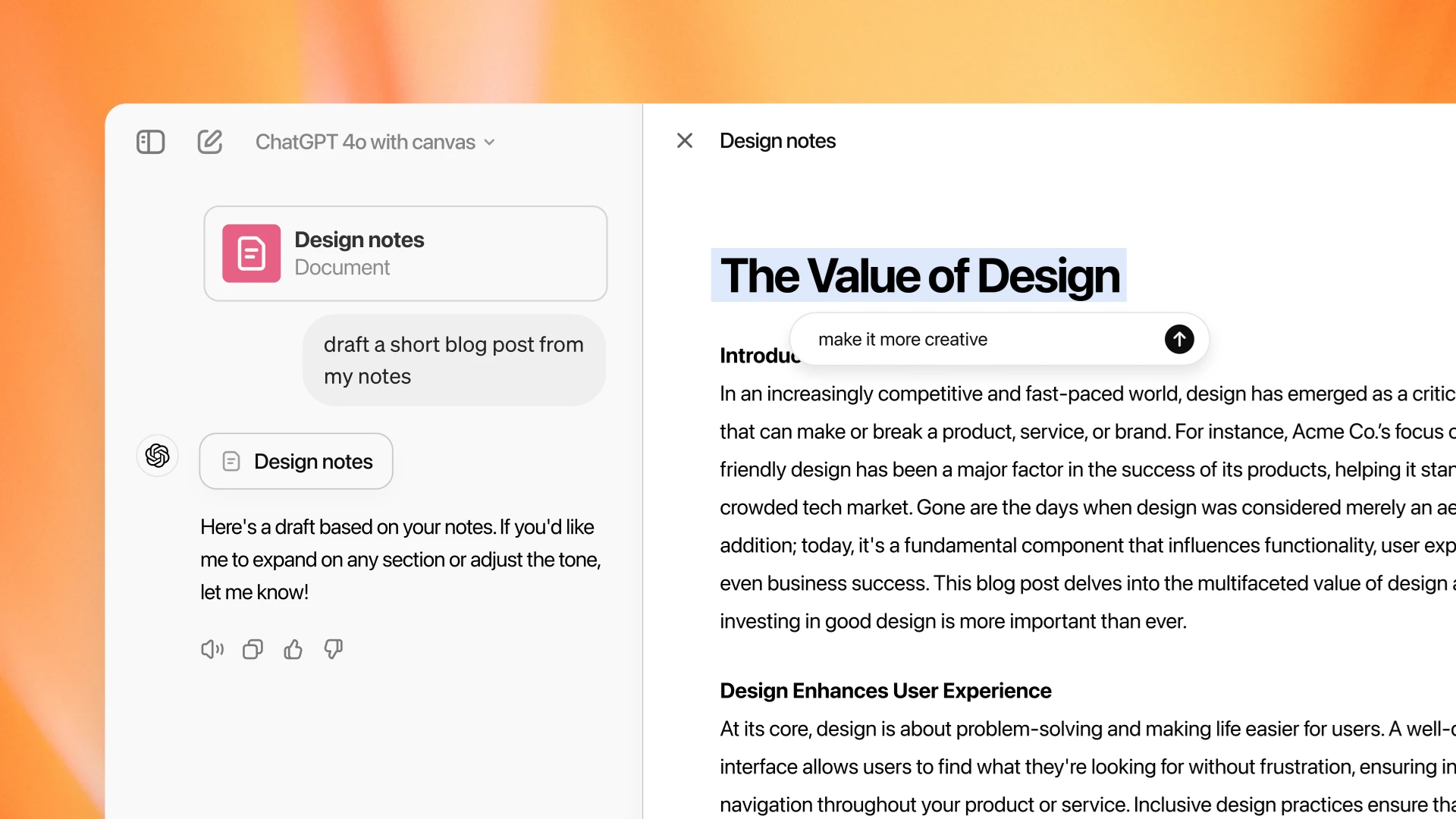ChatGPT's new 'Canvas' is the AI collaborator you didn't know you needed
Your AI editor will change just the parts you ask

ChatGPT has been writing text and software code since it debuted, but any fine-tuning of your prompt has required a full rewrite. OpenAI released a new feature called Canvas that offers a shared, editable page where ChatGPT can mimic a human collaborator and repeatedly edit or offer feedback on the particular parts of the text and code you select.
A useful way to think of Canvas is to imagine ChatGPT as your partner on a writing or coding project (you might even say 'copilot' if you were at Microsoft). Canvas operates on a separate page from the standard chatbot window, where you can ask the AI to write a blog post, code a mobile app feature, and so on. Instead of reading through the result and asking for a change in tone or adjustment to the code, you can highlight the specific bits you want changed and comment on the kind of edits you're looking for.
So, if you love what ChatGPT wrote for your newsletter except for the introduction, you could highlight those paragraphs and say you want it to be more formal or expand on a preview for the rest of the newsletter that's too short. You can do the same with editing your own writing if you share some text and ask for it to be longer or use less complex language. The suggestions even extend to asking ChatGPT for emoji ideas.
The same general idea applies to getting ChatGPT to edit code on Canvas, whether AI-generated or written by humans. You can ask ChatGPT to debug code, suggest improvements, or insert comments to make it more useful when sharing with actual humans. While emojis may not be relevant in coding software, you can use Canvas to ask ChatGPT to translate a program into another programming language, switching among them depending on what is most useful.
Canvas relies on the new GPT-4o model. For now, only ChatGPT Plus and Team subscribers have access, though it will be opened to Enterprise and Education clients soon. OpenAI will also make it available to those relying on the free tier of ChatGPT, but not until the beta stage is complete.
Canvas opens in a separate window, allowing you and ChatGPT to work on ideas side by side.In canvas, ChatGPT can suggest edits, adjust length, change reading levels, and offer inline feedback. You can also write and edit directly in canvas. pic.twitter.com/yHYVGtwJHVOctober 3, 2024
Blank Canvas
Canvas is a logical step in OpenAI's expansion of ChatGPT's features. It's a lot like a text version of the editing tools for AI-produced images made with OpenAI's DALL-E models. Instead of highlighting a part of an image and sending a prompt for how to change it, Canvas centers on text. Often, the text-based features come first and only later become multimodal in some form, so this is an interesting inverse of the standard release pattern.
The appeal to even the most casual ChatGPT users is obvious, as narrowly focused editing and suggestions are a lot more helpful than the one-dimensional conversational approach of ChatGPT's standard form. That's especially true when complex code or long-form text is involved. Of course, this might reasonably raise the hackles of educators and others already concerned with misuse or overreliance on AI-generated writing. It's one thing for a student to ask ChatGPT to write an essay for them; it's another when they can narrowly adjust the result to make it harder to spot any telltale signs of AI composition. Still, making ChatGPT a more active assistant and being able to task it to very specific issues is likely to be a huge boon in more legitimate pursuits, particularly when you need an editor who will never lose patience with you.
Get daily insight, inspiration and deals in your inbox
Sign up for breaking news, reviews, opinion, top tech deals, and more.
"People use ChatGPT every day for help with writing and code. Although the chat interface is easy to use and works well for many tasks, it’s limited when you want to work on projects that require editing and revisions," OpenAI explained in its announcement. "Making AI more useful and accessible requires rethinking how we interact with it. Canvas is a new approach and the first major update to ChatGPT’s visual interface since we launched two years ago."
You might also like...

Eric Hal Schwartz is a freelance writer for TechRadar with more than 15 years of experience covering the intersection of the world and technology. For the last five years, he served as head writer for Voicebot.ai and was on the leading edge of reporting on generative AI and large language models. He's since become an expert on the products of generative AI models, such as OpenAI’s ChatGPT, Anthropic’s Claude, Google Gemini, and every other synthetic media tool. His experience runs the gamut of media, including print, digital, broadcast, and live events. Now, he's continuing to tell the stories people want and need to hear about the rapidly evolving AI space and its impact on their lives. Eric is based in New York City.